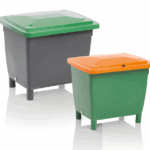As technology advances and so do our industries, a lot of things are changing. More companies are opting to use tech to improve their operations, but there’s one type of operation that hasn’t seen much change. Fortunately, retail has caught up with the times and is now using technology to improve inventory process. What does this mean for you? How about warehouse and distribution center tracking? Business intelligence? Completely automated receiving and shipping?
What is Inventory Management?
Inventory management is the process of ensuring that an organization has the correct amount of products and supplies to meet customer demand. It entails tracking inventory levels, forecasting future needs, and making decisions about when and how to produce or acquire products.
In order to stay competitive in today’s marketplace, retailers must have a sound inventory management process. Here are the ways technology can help you improve your inventory management system:
1. Track Inventory Levels with Technology
Retailers can use technology to track inventory levels in real time. This enables them to make informed decisions about when and how to produce or acquire products. For example, if a product is running low on stock, the retailer can order more from their supplier. Likewise, if there is an anticipated increase in customer demand, the retailer can order more products in advance.
2. Forecast Future Needs with Technology
Technology can also help retailers forecast future needs. For example, they can use data analytics to determine which products are in high demand and which ones could be discontinued soon. This information can then be used to make strategic decisions about which products to produce or acquire.
3. Automate the Process with Technology
Inventory management can be automated with technology. This can be done through several methods. For example, some retailers use bar codes to track which items are in stock and others use RFID technology for inventory management.
Science Stuff you need to know
Inventory is one of the most important processes in business. Not only does it help you manage your inventory and throughput, but it can also help you optimize your business model.
There are a number of ways to improve your inventory process with technology. Below are four tips to get started.
- Use an ERP or CRM system to keep track of your inventory levels and activity. This will give you detailed information about what’s selling, which items are in stock, and how much inventory you have left on hand. This can help you make better decisions about what to produce, when to produce it, and where to allocate resources.
- Use barcodes or RFID tags to track products as they move throughout the production process. This will let you know when products are damaged or lost, and will help you optimize your workflow accordingly.
- Use computerized scanners to automatically track product quantities as they’re produced. This will help you keep track of stock levels and make better decisions about how much product to produce next time around.
- Use software that can analyze sales data to identify patterns and trends that may indicate product shortages or overproduction.
Technology
There are a number of ways to improve your retail inventory process with technology, and the following are just a few examples.
1. Use Tracking Software
One popular way to improve your inventory process is to use tracking software. This software will allow you to keep track of what is in stock, what has been sold, and where each item is located in the store. This information can help you make better decisions about which items to stock, and which ones to sell.
2. Use RFID Technology
Another way to improve your inventory process is to use RFID technology. This technology allows you to automatically identify and track items as they move around the store. This information can be used to make better decisions about which items to stock, and which ones to sell.
3. Use Computer Aided Design (CAD) Software
Another way to improve your inventory process is to use computer aided design (CAD) software. This software can be used to create virtual models of the store layout, and then create a list of all the items that should be in each location. This information can then be used to create accurate inventories of the store contents.
4. Use Warehouse Management Software
Finally , if you are a smaller retailer and even if your inventory is changing more frequently, then you may use warehouse management software. Warehouse management software can be used to create automatic inventory updates for all of the items in your store. This system can also help you track inventory on hand and what supplies are running low on stock. Warehouse management software can also be used to set up advanced reports that show how many items are selling, or how much they are selling for.
Robotic Warehouse
One way to improve your inventory management process is to use robotics. A robotic warehouse can help you reduce the time it takes to get products into and out of stock, as well as the amount of time you spend in the warehouse. Here are four ways a robotic warehouse can help you improve your inventory:
- Automated retrieval and sorting: A robotic warehouse can help you automate the retrieval and sorting of products. This will reduce the time it takes to get products into and out of stock, as well as the amount of time you spend in the warehouse.
- Fast product turnaround: A robotic warehouse can help you turn products around quickly. This will reduce the amount of time you spend in the warehouse, and also save on storage costs.
- Reduced staff requirements: A robotic warehouse can help you reduce the number of staff required to manage your inventory. This will save on costs, both in terms of salary costs, as well as benefits packages.
- Improved safety: A robotic warehouse can help to improve safety in the workplace, by reducing the risk of accidents.
Conclusion
In today’s fast-paced world, it is essential that businesses are able to fluidly shift their inventory as demand changes. With the help of technology, you can streamline your inventory process and ensure that all products are in stock at all times. By implementing a system that tracks product information and analyzes sales trends, you can make informed decisions about how much product to produce and where to allocate your resources.






